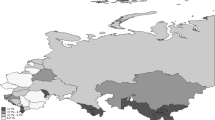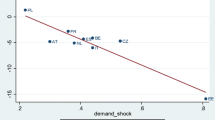Abstract
Firms' expectations regarding their ability to enter new markets and to develop new products, and concerning the foreign competition they will face in future, are strongly affected by the introduction of the euro. The following article analyzes these expectations using panel data taken from a quarterly business survey in the service sector.
Similar content being viewed by others
References
For a summary of new developments in the field of new real trade theory and existing studies dealing e.g. with the macroeconomic effects of European integration see Fritz Breuss: Außenwirtschaft Band I: Realer Teil, Schwerpunkt Europäische Integration, Springer Verlag, Wien 1997.
DIHT: Europäische Währungsunion vor dem Start: Zum Stand der Vorbereitung in den Unternehmen, IHK Euro-Reihe, 1998.
Cap Gemini Consulting: Euro Studie, Cap Gemini Consulting mimeo, 1998 (copy available at http://capgemini.de/de/ issuesdefault.html).
Andersen Consulting: L'Opinion des Chefs D'Enterprise Européens sur la Monnaie Unique, Andersen Consulting mimeo, 1998.
KPMG: Vorbereitung von Unternehmen auf die Europäische Wirtschafts- und Währungsunion: Forschungsbericht, KPMG mimeo, 1997 (copy available at http://www.kpmg.de/forum/presse1.html).
Gernot Nerb: Einfluß des Euro auf Unternemensstrategien, in: ifo-Schnelldienst, 17/18 (1998), pp. 13–18.
European Commission: One Market, one Money, in: European Economy, Vol. 44, 1990.
For a discussion of the impacts of exchange-rate variability, see Claudia Müller and Herbert S. Buscher: Exchange Rate Volatility Effects on the German Labour Market: A Survey of Recent Results and Extensions, ZEW mimeo, 1999.
Georg Licht, Christiane Hipp, Martin Kukuk, and Gunnar Münt: Innovationen im Dienstleistungssektor, Schriftenreihe des ZEW, Nomos Verlagsgesellschaft, Baden-Baden 1997.
Another notable exception is the study by Günther Ebling, and Norbert Janz: Export Behaviour and Innovation Activities in the Service Sector, ZEW mimeo, 1998, which relates exports to innovative activity.
Hans-Jörg Bullinger: Dienstleistungen für das 21. Jahrhundert, Schäffer-Poeschl Verlag, Stuttgart 1997: Sachverständigenrat: Wachstum. Beschäftigung. Währungsunion—Orientierungen für die Zukunft, Metzler-Poeschl, Stuttgart 1997; Sandra Waller: Struktureller Wandel—Konsequenzen für die amtliche Statistik und Konjunkturumfragen: Ausgewählte Beiträge von der 23. CIRET-Konferenz in Helsinki, in: ifo-Schnelldienst, 1997; Herbert Hax: Anforderungen an die Statistik zur Konjunkturbeobachtung und-prognose durch den Sachverständigenrat, in: Allgemeines Statistisches Archiv, Vol. 82, 1998, pp. 15–24.
More details on the SSBS can be found in Ulrich Kaiser and Herbert S. Buscher: Der Service Sentiment Indicator—Ein Konjunkturindikator für den Wirtschaftszweig unternehmensnahe Dienstleistungen, ZEW Dokumentation 98-04 (1998).
See Christian Homburg and Bernd Garbe: industrielle Dienstleistungen: Bestandsaufnahme und Entwicklungsrichtungen, in: Zeitschrift für Betriebswirtschaft, Vol. 66, 1996, pp. 253–282 for a survey.
H.-J. Hass: Industrienahe Dienstleistungen: Ökonomische Bedeutung und politische Herausforderung, In: Beiträge zur Wirtschafts- und Sozialpolitik, No. 223, 1995, Institut der deutschen Wirtschaft, Cologne.
Simone Strambach: Wissensintensive unternehmensnahe Dienstleistungen: Netzwerke und Interaktion. Universität Münster, Dissertation, 1995.
John A. Alic: Knowledge, Skill, and Education in the New Global Economy, in: Futures, Vol. 29, 1997, pp. 5–16.
Ulrich Kaiser: The Impact of Political Announcements on Expectations concerning the Starting Date of the EMU, in: ifo Studies, Vol. 44, No. 2, 1998, pp. 103–120.
Data are expanded by firm-proportional weights. Details on that procedure are given in: Ulrich Kaiser and Herbert S. Buscher, op. cit. Der Service Sentiment Indicator—Ein Konjunkturindikator für den Wirtschaftszweig unternehmensnahe Dienstleistungen, ZEW Dokumentation 98-04 (1998)
See James D. Hamilton: Time Series Analysis, Princeton University Press, Princeton 1994, ch. 22. 2, for details on transition probabilities and Markov chains.
See William H. Greene: Econometric Analysis, Prentice Hall, Upper Saddle River 1997, for details of the binary probit model.
George E.P. Box, and Donald R. Cox: An Analysis of Transformations, in: Journal of the Royal Statistical Society, Vol. 26, 1964, pp. 211–243.
See, inter alla, Joachim Wagner: Export Performance, Human Capital, and Product Innovation in Germany: A Micro View, in: Jahrbuch für Wirtschaftswissenschaften, Vol. 47, (1996, pp. 40–45; Katherine Wakelin: Innovation, Technological Spillovers and Export Behaviour at the Firm Level, MERIT discussion paper No. 2/96-020, 1996. Cf. Licht et al., op. cit. Innovationen im Dienstleistungssektor, Schriftenreihe des ZEW, Nomos Verlagsgesellschaft, Baden-Baden 1997.
Author information
Authors and Affiliations
Additional information
Helpful comments from our colleagues Friedrich Heinemann, Georg Licht and Herbert S. Buscher on earlier drafts of this paper are gratefully acknowledged. We are also indebted to Enrico Steeb and Rolf Kempkes for their helping hand in setting up the data set and to Christina Kaiser for research assistence. We also wish to thank Semka Thorvaldsen for proof-reading.
Rights and permissions
About this article
Cite this article
Kaiser, U., Stirböck, C. The impact of the introduction of the Euro on firms' expectations. Intereconomics 34, 107–115 (1999). https://doi.org/10.1007/BF02930162
Issue Date:
DOI: https://doi.org/10.1007/BF02930162




